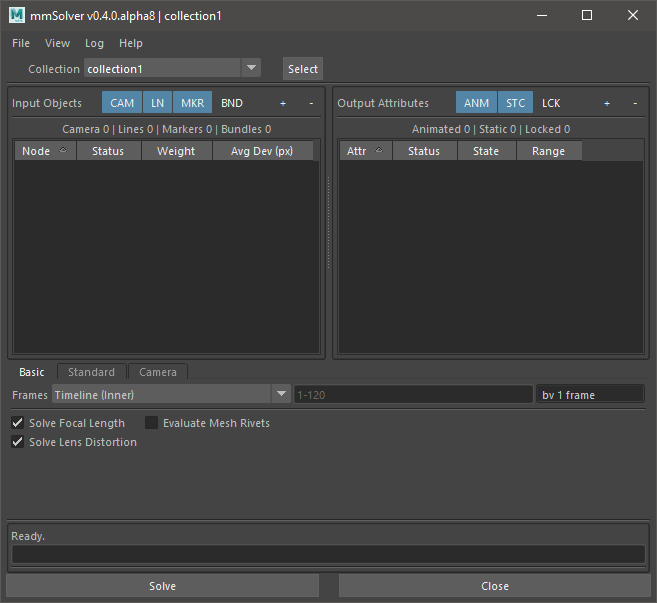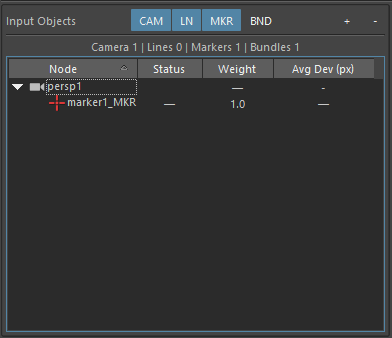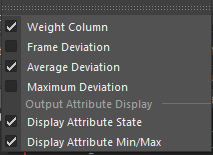Solver UI#
The Solver UI is the primary interface to using the internal solver command (mmSolver).

Solver User Interface#
The shelf tools will open or run the solver.

Input Objects#

The Objects are the inputs to the current Solve. This will display
of Markers used for detecting deviation.
To display the Markers, and the related objects, you may turn on/off
the CAM, MKR, LN and BND buttons.
There are various columns showing attributes of the input Objects. To display the column visibility, use the Edit menu.
Field |
Description |
|---|---|
Node |
The input Object’s Node. |
Weight |
The weight the Marker will have in the solver. Higher values give an importance to this Marker, at the expense of other Markers. |
Frame Deviation |
The deviation, in pixels, of the Marker on the current frame. |
Average Deviation |
The average deviation, in pixels, of the Marker across all valid frames. |
Maximum Deviation |
The maximum deviation and frame number on the Marker. |
Output Attributes#

This section of the UI shows the Attributes solved.
Field |
Description |
|---|---|
Attr |
The |
State |
The State column displays if the attribute is Static or Animated. |
Solver Tabs#
The Solver tabs define the different solvers and the options for each solver. The different solvers tabs share Common Solver Options, such as frame range, but each Solver tab is independent.
The documentation for each Solver tab is below.
Common Solver Options#
The options below are the same on one or many of the Solver tabs.
Frames#
The Frames option defines the list of frames to be solved.

Choose one of the options:
Option |
Description |
|---|---|
Current Frame |
Use the current Maya frame number to solve. |
Timeline (Inner) |
Use the frame range of the timeline inner bar. |
Timeline (Outer) |
Use the frame range of the timeline outer bar. |
Custom Frames |
Manually type the frame numbers to be solved. |
The frame numbers can be entered as ‘#-#’ to define a range, or ‘#,#,#,#’ to define a list of individual frame numbers. Examples are ‘1,10,20,30,40,50’ or ‘10-20,30,40-50’.
The ‘by # frames’ option allow skipping the every # frames. For example, with a value of ‘by 2 frames’, the every second frame is chosen; 1, 3, 5, 7, 9, etc. Using this tool can speed up solving a limited number of frames to build confidence in the solver attributes currently created, and then reducing this number to ‘1’ to solve each frame.
User and Root Frames#

The Root Frames are used to solve static and animated attributes, and are therefore not used with the Basic Solver Tab. Root Frames are chosen manually using the User Frames field, and automatically using the Per-Marker and Span options.
Beside the User Frames field are buttons for adding, removing and changing the current frame to the next/previous User Frame. For more details on tools to change frame, create or remove User Frames, see the Frame Tools.
The Per-Marker value is used to auto-detect the best frame numbers so that each Marker is sampled, to accurately triangulate a Bundle position. The smallest valid frames per-marker is 2.
The Span value makes sure that the largest gap between 2 Root Frames is at least 10 (or whatever value you use).
For example, with a Span value of 10, MM Solver starts with frames 1 and 95, then subdivides the frames in half choosing a value halfway between 1 and 95, 48. Next the same process happens on frames 1 and 48, and then again on frames 48 and 95, so you get: 1, 25, 48, 72, 95. The process the continues until the gap is at least 10 frames.
Therefore the full list of iterations look like this…
Iteration 1:
1,95Iteration 2:
1,48,95Iteration 3:
1,25,48,72,95Iteration 4:
1,13,25,37,48,60,72,84,95Iteration 5:
1,7,13,19,25,31,37,43,48,54,60,66,72,78,84,90,95
Solve All at Once#
Solve All at Once will solve all frames in a single solver step. This is the most accurate method of solving, because all Attributes and Frames are considered when reducing the error, however this is much slower.
Solve Only Root Frames#
Solve Only Root Frames will skip the last solver step when solving only animated attributes for the full frame range. As a result only Root Frames are solved and all other frames will not have keyframes.
Enable this option when you want to speed up the solver and get feedback faster, at the cost of solving each frame. Once you are confident your static values are correct you may re-enable this option, or solve with the Basic Solver Tab.
Solve Focal Length#
A toggle to allow focal length attributes to be solved. If this value is disabled, all camera focal length attributes will be ignored. This option is helpful to quickly enable/disable focal length attributes in the solver.
Solve Lens Distortion#
A toggle to allow lens distortion attributes to be solved. If this value is disabled, all camera lens distortion attributes will be ignored. This option is helpful to quickly enable/disable lens distortion attributes in the solver.
Evaluate Mesh Rivets#
When enabled, Evaluate Mesh Rivets will change the internal evaluation method to help solve “complex” node networks (such as Mesh Rivets which have cyclical node connection networks).
Evaluation of “complex” node graphs can significantly impact performance. It is recommended to turn this feature off unless the Maya scene is not evaluating correctly without this feature.
Mesh Rivets, using the classic rivet.mel script can be evaluated using this feature enabled.
Note
In mmSolver v0.3.x, this feature was known as Evaluate Complex Node Graphs.
Python Function#
The commands below are available for this tool, and allow hotkeys or custom buttons to be created.
Open the Solver UI window:
import mmSolver.tools.solver.tool as solver
solver.open_window()
Run the solve, just as if the user presses the “Solve” button in the UI:
import mmSolver.tools.solver.tool as solver
solver.run_solve()
Run the solve, with the “Override Current Frame” checkbox turned on:
import mmSolver.tools.solver.tool as solver
solver.run_solve_on_current_frame()
Run the solve, with the “Override Current Frame” checkbox turned off:
import mmSolver.tools.solver.tool as solver
solver.run_solve_on_all_frames()


